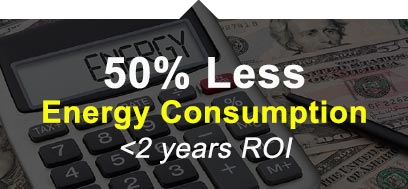Sales Literatures
Looking for ways to reduce your overall energy costs? Maybe you face state or federal energy mandates. Let The AMS Group show you how your operation is brimming with opportunity!
Supermarkets are the most electricity-intensive commercial buildings, using an average of 51.5 kilowatt-hours per square foot per year at a cost of about $3.70 per square foot per year. In terms of operating budget, energy is the second largest expense for food retailers after labor.
In fact, given the industry’s thin profit margin, it’s estimated that it takes $18 in sales to pay off $1 of the electric bill.
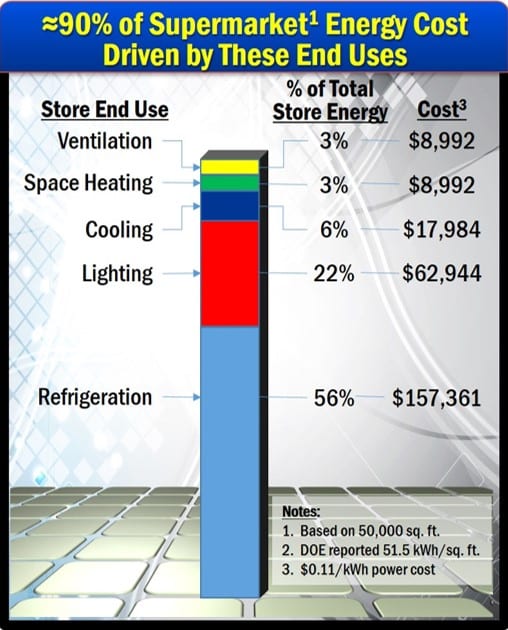
Close the Case & Slide Lids
Closing open-design, refrigerated display cases with doors or slide lids minimizes thermal losses to the surrounding ambient, thereby effectively reducing the overall refrigeration demand to keep the product in the case at optimal temperature.

Commissioning & Recommissioning
Commissioning and recommissioning of retail and industrial refrigeration systems assures that every start-up setting and process parameter meets engineering specification, resulting in increased lifespan of equipment, decreased energy usage, enhanced product integrity and reduced product shrink.

Close the Case Retrofit
Blow the Doors Off Energy Savings — By Putting Doors On
Open-design, refrigerated display cases, such as those found in the Deli, Dairy, Meat, Produce, or Beverage departments of retail food stores, inherently pose a host of problems and inefficiencies. Loss of refrigerated air to the ambient, product contamination, compromised product integrity and increased product shrink all add up to drag your profit down. Close the Case solves those problems and improves the merchandising of every open case simply by adding a door to it.
Cost Savings
Closed cases will save you up to 70% on energy costs compared to open cases. Demonstrating what a difference that could make to you:
- 400 Feet of Display Cases in a 50,000 Sq. Ft. Supermarket Can Save Up to $38,500 Per Year!
- Local utility companies often provide a rebate to reduce your initial investment.
- Closed cases increase efficiency and reliability by lowering refrigeration compressor loads by 80% or more. That freed-up capacity can be used for cases in other parts of the store.
- The number of defrost cycles is reduced with closed cases. That means less product shrinkage, consistent temperatures and ultimately safer food.
A Safer, More Attractive Place to Shop
Close The Case updates store appearances to provide a clean, attractive, more positive shopping experience all the while making shopping a safer experience for your customers by lowering the spread of airborne viruses and bacteria.
Close The Case Increases Profits
Close The Case keeps aisles up to 10° F warmer — keeping customers in the aisles longer. More comfortable aisles mean more comfortable customers — which leads to an improved customer shopping experience and ultimately more spending.
Closed doors keep case temperatures consistent and greatly reduce food spoilage thereby extending the product’s shelf life.
Bi-swing doors, which are available in a variety of styles, along with maintenance-free LED interior lighting which improves product illumination, result in significantly enhanced visibility of the product to the customer.
Employees spend less time in the aisles — no center mullions make re-stocking faster and easier resulting in decreased labor required. The AMS Group minimizes any interruption to your operation by performing the turnkey installation of these doors after-hours.
Slide Lid Retrofit
Don’t Let Your Profit Disappear into Thin Air!
Whereas vertical design display cases can benefit from saving energy and reducing cost with a Close the Case retrofit, horizontal design cases, such as islands, end caps and single-deck cases can achieve the same results with a Slide Lid retrofit.
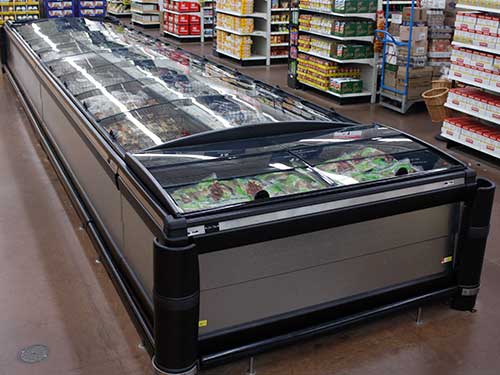
Contemporary Design
These contemporary, curved glass style lids slide vertically to minimize adjacent shopper interference. The lid serves to help keep any airborne contaminants out while not interfering with the customer’s visibility of the product. The usage of a slide lid provides a consistent, low temperature for frozen food products, greatly reducing food spoilage and extending the product’s shelf life.
Smart Glass
The lids are made with a low-emissivity glass, which serves to minimize thermal conductivity of the refrigerated air in the case to the surrounding ambient environment, resulting in 40% energy savings. Like Close the Case, this also offers the added benefit of making for warmer aisles surrounding the case — keeping customers in the aisles longer. More comfortable aisles mean more comfortable customers — which leads to an improved customer shopping experience and ultimately more spending.
LED Lighting
Shine a Light on Greater Profitability!
LED lighting brings improved merchandising opportunities and significant energy savings versus conventional lighting. In refrigerated display cases, lighting can create an environment with a huge impact on the overall feel, influencing a shopper’s buying experience. With planned and controlled use of the right light, you can enhance the customer’s journey, draw their eye and encourage them to explore and discover your products in new and exciting ways. New, high-color fidelity LEDs make food displays pop even more than traditional fluorescent counterparts, while LEDs for the general sales floor or industrial / commercial overhead lighting may save more than 33% of a store’s total lighting spend.
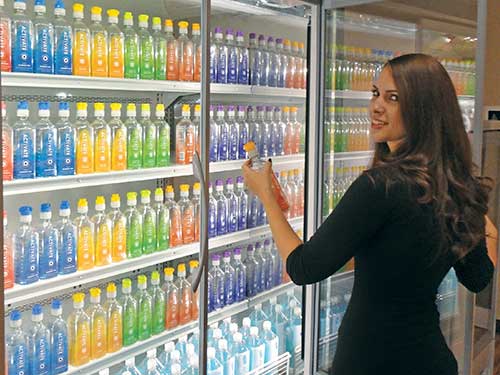
Take a look at some of the things that make LEDs a wise choice for your operation. After seeing the treasure trove of benefits awaiting you with LEDs, the question is not, “Why LEDs?”, but instead, “Why NOT LEDs?”
Merchandising
The physical dimensions of LEDs are smaller than their traditional lighting counterparts, making them discreet within the case, allowing the product to take center stage. They cover a wider range of the color spectrum, offering excellent CRI and a choice of color temperatures, allowing products and packaging to be displayed in their true colors.
Furthermore, information on packaging labels will not fade as there are no IR and UV wavelengths emitted. Ambient contrast and theatre can be created using LED solutions, as they are extremely directional and uniform, eliminating any spill or waste light onto the floor and surrounding areas. When applied properly, they remove dark spots with minimal glare.
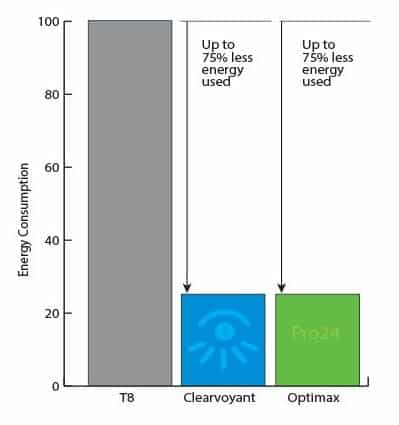
Long Lifetime … up to 20 year
LEDs have an operational life expectancy of up to 11 years when run continuously — 20 years if you were to run it for 8 hours per day. LED lifetime, which is 10 times greater than small fluorescent bulbs and 50 times greater than incandescent, means drastically less maintenance cost as well as lower long-term operating costs.
Efficiency … 80% – 90% less power
LEDs use 80% – 90% less power than traditional lighting. The dramatic decrease in power costs goes a long way to help reduce the money you dish out every month towards your utility bills. And all of this is yours with a speedy payback on your investment — typical ROI for changeout of fluorescent lighting to LED is between 1.5 and 2 years.
Eco-Friendly
Unlike neon lighting that uses mercury which may pose a danger to the environment, LED lights contain no toxic materials and are 100% recyclable.
Durability
Because LEDs are not made of glass and are hollow inside, they are much more durable and able to withstand harsh conditions. They don’t emit heat in the same way that electric bulbs do and are therefore able to easily withstand harsh transitions between hot and cold. LEDs perform better at low temperatures and do not produce radiated heat like their T8/T5 counterparts, making them ideal for refrigeration applications.
Safety
Unlike incandescent and fluorescent bulbs, LEDs are easy to the touch even after they are on for hours, so they carry less risk of causing an accidental fire or burn.
Dimmability
LEDs can be dimmed, resulting in a dynamic control of light, color, flexibility, and distribution. This enables a wide variety of merchandising opportunities.
Light Distribution
Fluorescent lights provide a diffuse light in all directions, whereas LED lighting fixtures have been designed to provide directional illumination at 70-160° as needed in the case. Importantly, the quality of light in the case can also be improved to reduce glare, eliminate hot spots and make the food and packaging more appealing through better color rendering — all of which enhances the merchandising of your product.
With LEDs in your display cases or sales floor, you can have it all; increased performance with reduced cost of ownership. Now, that’s a “win-win”!
SweatMiser
Want to Save Some Serious Energy? … No Sweat!
Refrigeration accounts for fully 50% of a supermarket’s total energy costs, with 30- 40% of that directly related to compressor run time. It’s easy to see how small fluctuations in compressor loads — up or down — can really affect total energy consumption. Moisture collecting on the doors of refrigerated (MT) cases and freezers (LT) can increase refrigerator loads and even lead to coils icing up, a major maintenance headache. By design, there could be heat on the door glass, the frames around the glass, and the frames on the cases to prevent this moisture from forming on the glass and frames. But did you know that heat is needed only a fraction of the time to be effective? Still many stores have uncontrolled heat applied, which is present all day, every day. This is wasted electricity – and money – in the form of using more heat than is needed and the increased refrigeration load to compensate for it.
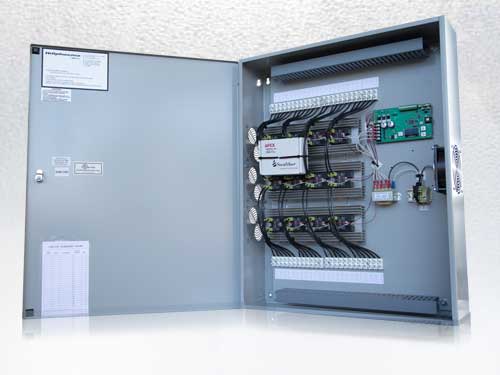
Not All Anti-Sweat Solutions Were Born Equal
Anti-sweat heater controls are a great solution. They monitor the ambient conditions in the store and pulse heat only as needed to keep door temperatures above the store’s dew point and thus condensation-free. But not all anti-sweat heater solutions were born equal. Many require a controller to be installed in each and every case, which increases both installation costs and chances for equipment failure. SweatMiser, a better, more cost-effective solution, is a single, centralized unit that can manage multiple zones within a store, delivering only the heat that’s needed to each. The SweatMiser controller monitors the dew point outside the case 24/7 with a sensor which continuously relays its data to the controller’s electronics which determines what percentage the heaters’ pulse rate needs to be in order to keep the frame and glass temperatures elevated above it and prevent the formation of sweat.
Many utilities have approved SweatMiser as an energy savings measure, qualifying it for applicable rebates. Simple paybacks of less than one year are possible depending on store configuration, location, energy costs and available incentives.
Up to 50% Less Door Heater Energy with SweatMiser
With SweatMiser, you can save up to 50% on energy consumed by door heaters. SweatMiser also provides the option of turning heat off during utilities’ peak demand periods (typically between noon and 6 PM), when rates can be as much as 10 times higher than in off-peak periods. You don’t have to wait long to see the savings on your investment as SweatMiser has an average ROI of less than 2 years. Multiple models are available to choose from in order to meet the specific needs of your operation.
ROI Example — Below is an ROI table on the 5 stores in Tampa, Florida (harsh climate) using the savings data from April as the year-round average.
Commissioning & Recommissioning
Big Improvements Often Start with Little Things
Commissioning or recommissioning is a systematic approach to identifying and implementing operational and maintenance improvements to ensure continued performance to manufacturer’s specifications. The only difference between the two is commissioning is performed on new system installs, whereas recommissioning is done with existing systems.
Over time, changes in equipment set points and equipment use can significantly and negatively impact energy costs, as well as equipment life cycle and productivity. By undertaking a modest recommissioning project, a customer can bring refrigeration equipment performance back to its original installed state and achieve significant savings in the process.
When it comes to a grocery store, the environment of the store is also important. How it is lit, how comfortable the space is for shoppers, and the freshness and proper temperatures of food are key factors in the total shopping experience.
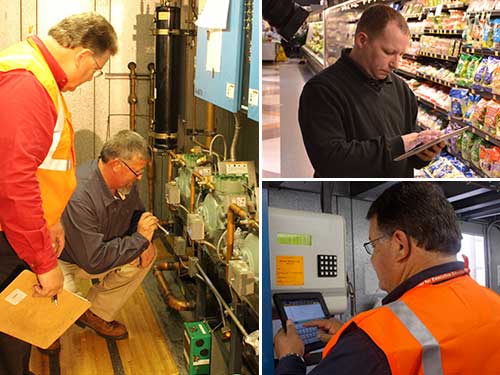
Save Big and Save Soon!
The US Department of Energy states an effective grocery store energy upgrade begins with a store recommissioning which identifies opportunities of improvement for refrigeration, lighting, and HVAC systems. These areas make up 90% of a store’s total energy use and improvements from a recommissioning effort typically have a simple payback of 1.1 years or less*.
*US DOE’s Advanced Energy Retrofit Guide: Grocery Stores (2013)
Recommissioning — The Backbone to Any Energy Savings or Store Upgrade
Recommissioning may be done either periodically to ensure a store’s systems are operating at their designed setpoints or after performing significant maintenance, replacement, or upgrades to a store which fundamentally change how the store will perform.
Additionally, recommissioning may be done at different levels, from whole store recommissioning to system-specific recommissioning (such as: refrigeration, lighting, and HVAC).
Some of the benefits you’ll receive from a recommissioning project include:
- The equipment set-up is returned to its original design specifications. This ensures that the equipment is operating as designed and is within proper and optimal operating parameters.
- It provides the opportunity to go through the store, with the assistance of a Hillphoenix AMS technician, and create a deficiency list of items (with pictures and documentation) requiring corrective action. Correcting these items results in increased system efficiency and a lower total cost of ownership.
- It reduces service calls and equipment downtime while at the same time increasing the life expectancy of the equipment.
- It includes quarterly, remote quality verification involving remote monitoring access for a Hillphoenix AMS technician to perform quarterly monitoring and set point verification.
- Last but not least, it achieves the goal of saving energy without the risk of damaging product integrity
Not All Anti-Sweat Solutions Were Born Equal
Anti-sweat heater controls are a great solution. They monitor the ambient conditions in the store and pulse heat only as needed to keep door temperatures above the store’s dew point and thus condensation-free. But not all anti-sweat heater solutions were born equal. Many require a controller to be installed in each and every case, which increases both installation costs and chances for equipment failure. SweatMiser, a better, more cost-effective solution, is a single, centralized unit that can manage multiple zones within a store, delivering only the heat that’s needed to each. The SweatMiser controller monitors the dew point outside the case 24/7 with a sensor which continuously relays its data to the controller’s electronics which determines what percentage the heaters’ pulse rate needs to be in order to keep the frame and glass temperatures elevated above it and prevent the formation of sweat.
Many utilities have approved SweatMiser as an energy savings measure, qualifying it for applicable rebates. Simple paybacks of less than one year are possible depending on store configuration, location, energy costs and available incentives.
Up to 50% Less Door Heater Energy with SweatMiser
With SweatMiser, you can save up to 50% on energy consumed by door heaters. SweatMiser also provides the option of turning heat off during utilities’ peak demand periods (typically between noon and 6 PM), when rates can be as much as 10 times higher than in off-peak periods. You don’t have to wait long to see the savings on your investment as SweatMiser has an average ROI of less than 2 years. Multiple models are available to choose from in order to meet the specific needs of your operation.
The AMS Group — EC Fan Motors
Saving You Energy … Quietly!
The usage of electronically commutated (EC) motors in refrigeration equipment evaporator fans is not new. They have been used over the past decade as an alternative to the more standard induction motors, such as shaded pole (SP) and permanent split capacitor (PSC) motors. Although EC motors can reduce energy consumption by as much as 65% compared to induction motors, their cost in the past has limited their usage in retail food applications. But as is true with most new technologies, it was only a matter of time before the price became more attractive. Today, EC motors are essentially standard equipment on evaporator fans in new refrigerated display and freezer cases.
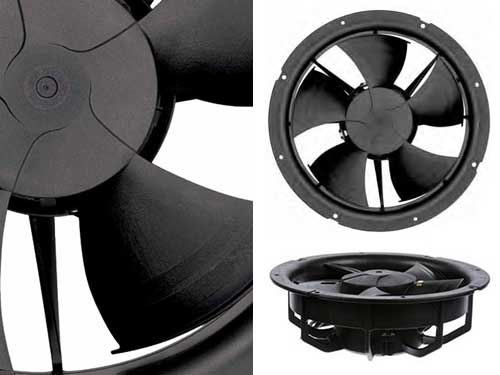
33% to 66% Less Energy with EC Fan Motors
Basically, an EC fan motor is a brushless DC motor using a normal AC supply — utilizing the inherent advantages of both technologies to produce a component that “moves more air, more quietly using 33% to 66% less energy” than its SP and PSC counterparts. The EC motor incorporates the AC to DC voltage transformation within the motor. The non-rotating part of the motor (stator) is extended to make room for an electronic PCB board which includes power transformation of AC to DC, as well as the electronic controls.
2X the Efficiency of PSC and 4X the Efficiency of SP Fan Motors
Typically, AC motors have losses in terms of power consumption (copper + iron losses), slippage and frictional losses (mechanical power). EC motors have no such slippage losses, translating to increased efficiency through less power required to do the job of moving the same amount of air. In general, shaded pole (SP) motors range from 15-25% efficiency, permanent split capacitor (PSC) motors range from 30-50% efficiency and EC motors achieve 60-75+% efficiency.
EC technology motors have a near flat efficiency curve which barely varies across the speed range — a range not limited by synchronous speeds or susceptible to voltage variations like its AC counterpart. Its AC equivalent will operate at a precise point on the curve which equates to its maximum efficiency, either side of this point and the efficiency diminishes. EC fan motors can be programmed to operate at the exact speed needed without wasting energy.
A Single Drop-In Retrofit Is the Perfect Fit for Every Case
And now, here’s the really good news — you don’t have to spring for new cases in order to reap the benefits of ECM fan motors for your operation. With easy-to-install evaporator fan retrofits from the Hillphoenix AMS Group, you can start enjoying the benefits and energy savings immediately. The fan retrofits feature an EC motor with fiberglass-reinforced plastic blades, orifice, and fan basket all in one durable, pre-constructed unit that’s optimized for noise reduction and airflow. Models are available to fit plenums in all islands, cases and walk-in evaporators.
Installation is a breeze! Easy connection — no complicated wiring and set-up. With the push of a few buttons, a hand-held digital programmer sets the optimal fan speed without needing to replicate the blade pitch of the fans you’re replacing.
More Airflow, Less Noise
PSC motors are noisy, and to keep the noise down, must operate at less than a full load. Efficiency suffers as a result, losing as much as 45%. EC fan motors do not have these limitations.
The better design and durability of EC fan motors also mean better airflow than traditional aluminum blades. The next time you’re in a supermarket, stop a moment and listen carefully to what customers hear — racket, clatter, vibration. That’s the noise of out-of-balance evaporator fans with bent, dinged-up aluminum blades. When aluminum blades become deformed they no longer move air in the way which they were designed. Along with resisting deformation that compromises airflow, the blades on Hillphoenix AMS Group EC fan motors feature winglets that maximize air movement while reducing noise. They will be as quiet years down the road as they were on their first day of their operation — a difference your shoppers will appreciate.
Rugged Design and Durability Assure Years of Performance and Savings
Hermetically sealed stator assembly, formed-in-place gasketing and fully coated electronics ensure that EC motors are made to withstand the demands of a wet environment application.
Full ball bearing assemblies allow for mounting in any position and provide exceptional fan life, normally beyond 60,000 hours (6.8 years).
With no brushes to wear out and a motor that runs at lower temperatures than its AC equivalent, EC fan motors have a longer lifetime than their SP and PSC counterparts.
Complete fan assembly kit includes a matched-grade motor with fan blade and wall ring designed to work together for optimum performance (air flow, vibration and sound).
The fiberglass-reinforced, engineered plastic blades are designed and tested for durability. In lab tests, blades were subjected to impact from ice cubes and 2-inch steel balls with no damage.
A 2-Year Warranty with Quick Payback
Hillphoenix AMS Group evaporator fan retrofits integrate the energy efficiency of the EC motor with the durability and quiet performance of reinforced, engineered plastic for a solution that comes with a long warranty period and a short payback period. With utility incentives for energy efficiency, you can typically expect to further reduce payback from well under 2 years to less than 1 year.
